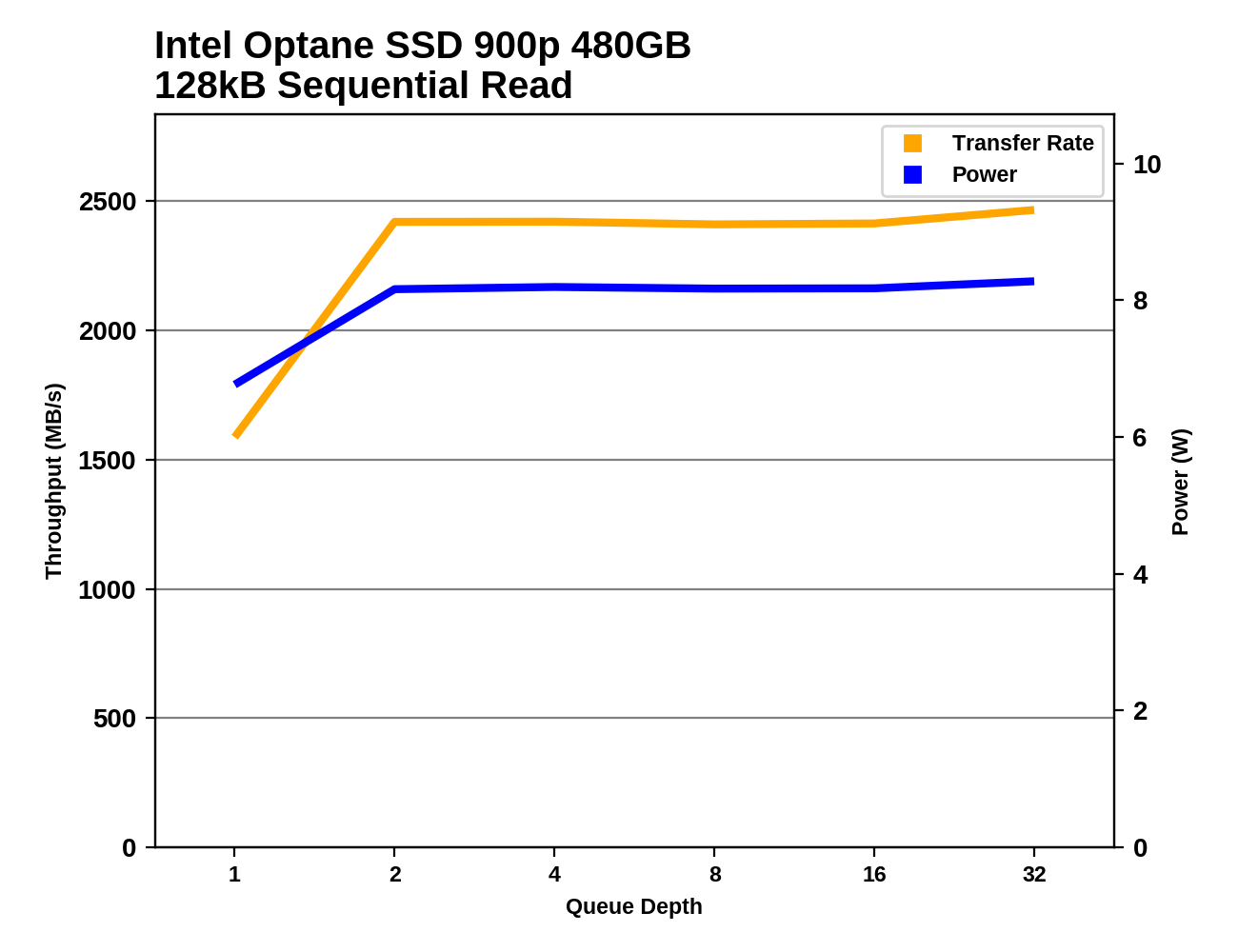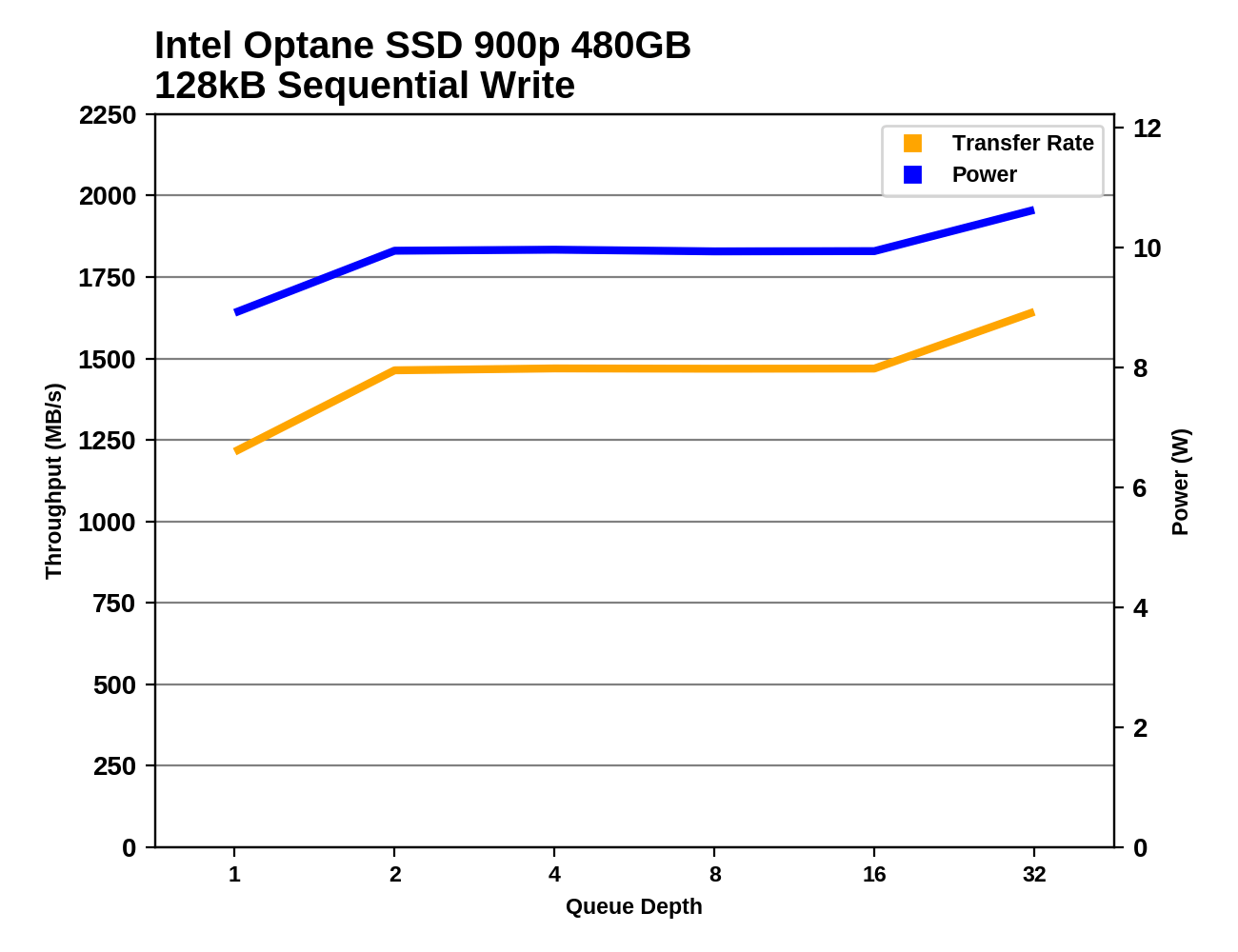The Intel Optane SSD 900p 480GB Review: Diving Deeper Into 3D XPoint
by Billy Tallis on December 15, 2017 12:15 PM ESTSequential Read Performance
Our first test of sequential read performance uses short bursts of 128MB, issued as 128kB operations with no queuing. The test averages performance across eight bursts for a total of 1GB of data transferred from a drive containing 16GB of data. Between each burst the drive is given enough idle time to keep the overall duty cycle at 20%.

Despite having incredibly low access latency, the Optane SSD 900p doesn't beat the fastest flash-based SSDs in our burst sequential read test. The fastest flash SSDs make up for their slower initial response time through a combination of higher channel counts, prefetching and most likely larger native block sizes. The Optane SSD 900p still has a great score here, but it fails to stand out from the much cheaper flash-based drives.
Our test of sustained sequential reads uses queue depths from 1 to 32, with the performance and power scores computed as the average of QD1, QD2 and QD4. Each queue depth is tested for up to one minute or 32GB transferred, from a drive containing 64GB of data.

With the test of higher queue depths and longer run times, the Optane SSDs are back on top with a substantial performance lead. Unlike the burst test, this test shows almost no performance difference between the two capacities of the Optane SSD 900p.

The performance lead of the Optane SSD 900p isn't enough to make up for its higher power consumption, so the 900p ends up in the second tier of drives for sequential read power efficiency, alongside Samsung's 960 generation and the Toshiba XG5.
 |
|||||||||
The 480GB Optane SSD 900p draws about 0.6–0.75W more than the 280GB model during the sequential read test, putting it just over 8W total when operating at full speed. Even the smaller 900p is still over 6W at QD1, while the flash-based SSDs are mostly in the 4-5W range. (The Intel SSD 750 breaks 9W at higher queue depths.)
Sequential Write Performance
Our test of sequential write burst performance is structured identically to the sequential read burst performance test save for the direction of the data transfer. Each burst writes 128MB as 128kB operations issued at QD1, for a total of 1GB of data written to a drive containing 16GB of data.

The burst sequential write performance of the Intel Optane SSD 900p is on par with some of Samsung's older NVMe SSDs, but is exceeded by the 960 generation and the PM981.
Our test of sustained sequential writes is structured identically to our sustained sequential read test, save for the direction of the data transfers. Queue depths range from 1 to 32 and each queue depth is tested for up to one minute or 32GB, followed by up to one minute of idle time for the drive to cool off and perform garbage collection. The test is confined to a 64GB span of the drive.

On the longer sequential write test, the Samsung PM981 falls out of first place and ends up substantially slower than the Optane SSD 900p, but the Samsung 960 PRO and EVO are still faster than the 900p.

The power efficiency of the Optane SSD 900p during sequential writes is worse than most M.2 NVMe SSDs, though not as bad as the extremely power-hungry Intel SSD 750.
 |
|||||||||
The two capacities of the Optane SSD 900p offer essentially identical sequential write performance. As with sequential reads, the difference in power consumption between the two capacities is about 0.75W, but the writes require about than 2W more than the reads.










69 Comments
View All Comments
eddman - Sunday, December 17, 2017 - link
That graph explains the situation perfectly. Even if the media's latency was somehow magically reduced to zero, the total storage latency would still be only about 6 times better.It's all pointless though; ddriver's personal hatred towards intel and "the corporations" prevents him from thinking differently. As soon as he finds a number that is different from what was mentioned in the promotional materials, the first thing he does is to start shouting "liar, liar".
P.S. I have zero love for corporations and can't stand when one takes advantage of the users. What I also can't stand is a person spreading unsubstantiated claims and spamming a technology website's comment section to offload his hate in order to feel better.
tuxRoller - Friday, December 15, 2017 - link
Also z nand appears to be mlc cells operating in SLC mode, and that's still slower than first gen xpoint.hescominsoon - Friday, December 15, 2017 - link
Intel has walked back the 100x bs claims. Also notice how micro(their partner in this venture) has NOT released their side of this product?https://semiaccurate.com/?s=optane
tuxRoller - Saturday, December 16, 2017 - link
They walked them back? Maybe for these nvme products, though I've not seen anything about that. The real test is how well they'll do as direct addressed memory when used in the DIMM configuration.Reflex - Friday, December 15, 2017 - link
SLC has no significant advantages over Optane. Optane is nearly across the board a better performer, often by a significant margin, than any commercial NAND technology. The two drawbacks that are important right now are power consumption and cost (these are also drawbacks of SLC for the record)The complaints about Intel's 'hype' are misconstrued. There is a huge difference between discussing what a technology is capable of, and what individual products derived from that technology can deliver. That some people had reading comprehension problems is not Intel's problem, they are delivering what they promised, and as the rest of the supporting infrastructure improves over time we know based on their initial statements that Optane/PCM can scale to match it.
CheapSushi - Friday, December 15, 2017 - link
The industry is trying. It's called Z-NAND.ddriver - Friday, December 15, 2017 - link
Which is MLC...Samsung realized nobody is catching up in the nand market and decided to push consumer, high end and mainstream enterprise a notch down to TLC.
So now that MLC is only a "high end enterprise" thing in their portfolio, they decided to pimp it up with a new moniker - z-nand. Alas, it is just good old MLC with a barely incremental controller. And claim that it has anything to do with SLC performance - which it does as much as an a race horse harness makes an old donkey faster.
They REALLY aren't trying.
CheapSushi - Saturday, December 16, 2017 - link
It's MLC & TLC 3D NAND treated exactly like SLC (1 bit per cell) with a better controller and special sauce, effectively making it as if it was SLC in the first place and a better SLC driver than previous SLC drives that came out. So what is the issue? It's not a completely separate NAND production line?ddriver - Saturday, December 16, 2017 - link
Do you realize parroting nonsense you are clearly completely ignorant of doesn't win you bonus points?There is no such thing, you have to compromise one for the sake of the other. It is just more mature and a tiny bit better than previous gen MLC, but it is not even half of what can be squeezed of contemporary SLC.
"Special sauce"? It is sad to see average Joe hans't moved up a bit since the middle ages.
drajitshnew - Saturday, December 16, 2017 - link
No "ryzen" in opposition to their "core". The flash industry is in a race to see who can make the CHEAPEST PoS